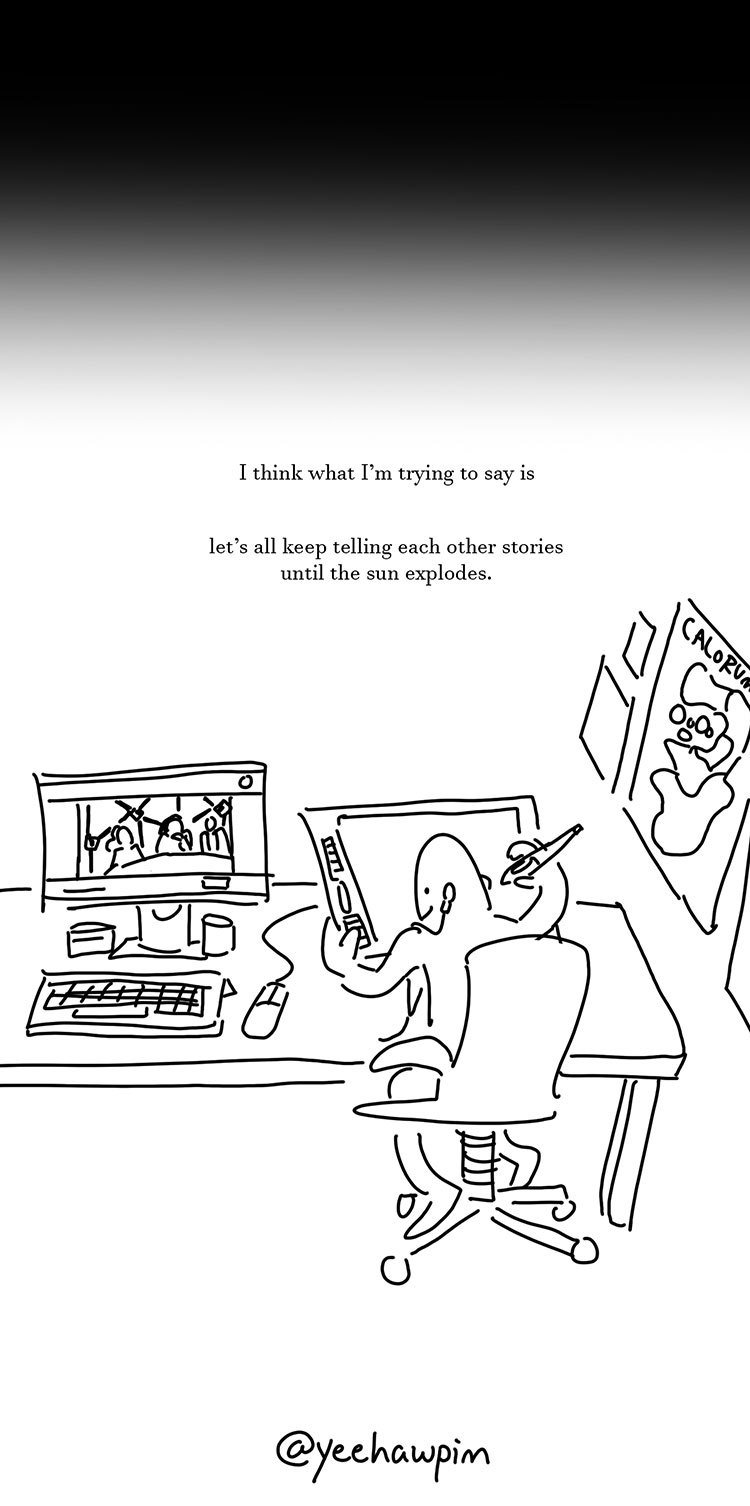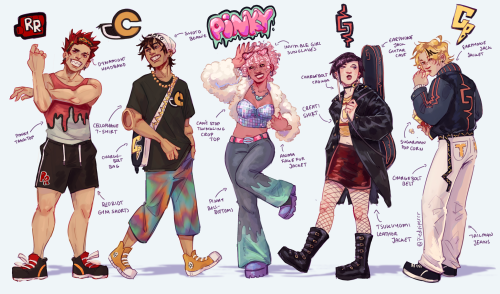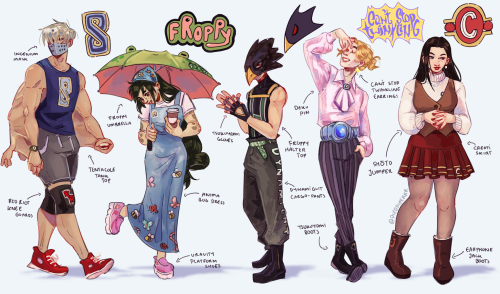Okay Like
okay like








literally love triangle between twins with daddy issues and connection to the force and sassy hero boy who cant say i love you. i think ive seen this film before......
More Posts from Bardofanauthor and Others
💗💗💗
kirishima would be so happy to see barbie with you btw


Can I kick it? (Yes, you can!)
“say you won’t let go” - some touch starved scenarios
prompt list by @novelbear
heart pounding whenever the other does so much as to hold onto their wrist while guiding them through a crowd
one just casually sitting down on the other's lap and they start internally freaking the hell out
hesitantly tugging the other's fabric of their shirt or sleeve, testing the waters
^^ the other notices so they pull them into a hug, smiling as they just watch them melt
"wait, don't go, please.."
"is this okay?" "it's more than okay."
already barely holding it together as they're getting their hand held but then they feel that reassuring squeeze and they just can't
wearing the others' clothes so that it can at least feel like they're hugging them, even for just a moment
feeling so lonely that they have to call their lover/friend, just to get a sense and reminder that they're still there
^ trying and failing to hold back their tears as they do so
"can i have one more hug?" "aw, babe you don't have to ask, c'mere..."
when the other holds onto their waist briefly as they're passing by and it just send chills down their spine
breaking down mid-hug because they just needed this so much
their breath hitching whenever the other gets a little closer
^ feeling crushed when that action is taken as a sign of discomfort, and they watch them slowly back off
holding onto a stuffed animal/pillow, imagining that it's their lover in their embrace instead
one leaning their head onto the other's shoulder suddenly and they just freeze
"i wasn't sure how much longer i could have taken this..."









a comic about different types of storytellers
petition to make it real:
It needs to be real for me.
a scooby doo series set in community college where the gang is in a criminology class and end up in a huge debate on the first day of class that leads to them starting a podcast talking about local urban legends, only to realize things aren’t quite adding up and they go to investigate for ~journalistic authenticity~ and end up solving a real-life crime disguised as supernatural occurrences. this happens every week and they’re frequently featured on the school newspaper. they only have twenty listeners
one of the best fics i've ever read, one that had me addicted to my phone and crying, wasn't even prose. it was a huge, casual, bullet-pointed outline with every detail of an au that the author never got around to writing in full. and it was amazing.
let this be a message to all you who want to write but can't do it "normally": write it! someone out there will eat it up. whether that be poetry, tiny drabbles, or bullet pointed list: your work is always worth it. your art (yes, art!) will alway deserve to have its moment in the spotlight. why? because you made it. even if it wasn't done in a traditional matter, it came from your brain and your creativity and that is amazing.
♡
How to write about someone’s appearance? Their physique, styles, face , clothes,?
How to Describe a Character's Appearance
-> dabblewriter.com
-> link to Character Description Prompts
Avoid Over-Describing
Overloading readers with too much information can be overwhelming and make your characters feel flat and one-dimensional. Focus on the details that are the most important to the story and the characters themselves.
If the character's appearance is not central to the story, then you may only need to give a basic description. If it plays a significant role, you may want to go into more detail. Always keep the purpose of your physical descriptions in mind.
Show Don't Tell
Don't blatantly state every little thing about your character's appearance, but rather show it through their actions and behaviors.
example: If they are tall, show that through their actions. They have to duck to get under a doorway, they help someone reach the top shelf, etc.
Include Personality Traits
A character's personality is what makes them memorable. Consider their motivations, values, beliefs, and quirks and give them a well-defined personality.
Avoid Stereotypes
Create characters that are more than just their cultural, racial, ethnic, or gender identity. Give them unique interests, hobbies, and personalities. Allow them to have flaws, contradictions, and diverse perspectives.
External Features
External features include a character's height, weight, body type, and general appearance. You can describe their skin color, hair color, eye color, and any distinctive features like freckles or scars. This type of description gives the reader a basic understanding of what the character looks like, which is helpful in creating a mental image.
Clothing
Describing the type of clothing they wear, including the colors, patterns, and how they fit, can reveal a lot about a character’s personality and social status.
For example, a character who wears tailored suits and expensive shoes might be a little snobby and concerned with their image, while a character who wears ripped jeans and t-shirts might be casual and relaxed.
Facial Features
Facial features can be used to give the reader a more in-depth understanding of a character's personality and emotions. You can describe their smile, the way they frown, their cheekbones, and their jawline. You can also describe their eyebrows, the shape of their nose, and the size and shape of their eyes, which can give the reader insight into their emotions.
Body Language
Body language can be used to give the reader an understanding of a character's emotions and personality without the need for dialogue. Describing the way a character stands, walks, or gestures can reveal a lot about their confidence level, mood, and attitude.
For example, a character who slouches and avoids eye contact is likely to be shy, while a character who stands up straight and makes direct eye contact is likely to be confident.
Words to Describe Various Features
Head and face
Oval: rounded, elongated, balanced, symmetrical
Round: full, plump, chubby, cherubic
Square: angular, defined, strong, masculine
Heart: pointy, triangular, wider at the temples, narrow at the chin
Diamond: angular, pointed, narrow at the forehead and jaw, wide at the cheekbones
Long: elongated, narrow, oval, rectangular
Triangular: angular, wide at the jaw, narrow at the forehead, inverted heart-shape
Oblong: elongated, rectangular, similar to oval but longer
Pear-shaped: narrow at the forehead, wide at the jaw and cheekbones, downward-pointing triangle
Rectangular: angular, defined, similar to oblong but more squared
Facial features
Cheeks: rosy, plump, gaunt, sunken, dimpled, flushed, pale, chubby, hollow
Chin: pointed, cleft, rounded, prominent, dimpled, double, weak, strong, square
Ear: large, small, delicate, flapped, pointed, rounded, lobeless, pierced
Eyes: deep-set, angled, bright, piercing, hooded, wide-set, close-set, beady, slanted, round, droopy, sleepy, sparkling
Forehead: high, broad, wrinkled, smooth, furrowed, low, narrow, receding
Jaw: strong, square, defined, angular, jutting, soft, weak, chiseled
Lips: full, thin, chapped, cracked, puckered, pursed, smiling, quivering, pouty
Mouth: wide, small, downturned, upturned, smiling, frowning, pouting, grimacing
Nose: hooked, straight, aquiline, button, long, short, broad, narrow, upturned, downturned, hooked, snub
Eyebrows: arched, bushy, thin, unkempt, groomed, straight, curved, knitted, furrowed, raised
Hair
Texture: curly, straight, wavy, frizzy, lank, greasy, voluminous, luxurious, tangled, silky, coarse, kinky
Length: long, short, shoulder-length, waist-length, neck-length, chin-length, buzzed, shaven
Style: styled, unkempt, messy, wild, sleek, smoothed, braided, ponytail, bun, dreadlocks
Color: blonde, brunette, red, black, gray, silver, salt-and-pepper, auburn, chestnut, golden, caramel
Volume: thick, thin, fine, full, limp, voluminous, sparse
Parting: center-parted, side-parted, combed, brushed, gelled, slicked back
Bangs: fringed, side-swept, blunt, wispy, thick, thin
Accessories: headband, scarf, barrettes, clips, pins, extensions, braids, ribbons, beads, feathers
Body
Build: slender, skinny, lean, athletic, toned, muscular, burly, stocky, rotund, plump, hefty, portly
Height: tall, short, petite, lanky, willowy, stocky, rotund
Posture: slouching, upright, hunched, stiff, relaxed, confident, nervous, slumped
Shape: hourglass, pear-shaped, apple-shaped, athletic, bulky, willowy, curvy
Muscles: defined, toned, prominent, ripped, flabby, soft
Fat distribution: chubby, plump, rounded, jiggly, wobbly, flabby, bloated, bloated
Body hair: hairy, smooth, shaven, beard, goatee, mustache, stubble
Weight: light, heavy, average, underweight, overweight, obese, lean, skinny
Body language: confident, nervous, aggressive, submissive, arrogant, timid, confident, relaxed
Body movements: graceful, clunky, fluid, awkward, jerky, smooth, agile, rigid
Build
Muscular: ripped, toned, defined, well-built, buff, brawny, burly, strapping
Athletic: fit, toned, agile, flexible, energetic, muscular, athletic, sporty
Thin: skinny, slender, slim, lanky, bony, gaunt, angular, wiry
Stocky: sturdy, broad-shouldered, compact, muscular, solid, robust, heavy-set
Overweight: plump, chubby, rotund, heavy, portly, corpulent, stout, fleshy
Fat: overweight, overweight, rotund, heavy, bloated, tubby, round, fat
Lean: lanky, slender, skinny, thin, wiry, willowy, spare, underweight
Larger: large, heavy, hefty, substantial, solid, overweight, portly, rotund
Skin
Texture: smooth, soft, silky, rough, bumpy, flaky, scaly, rough
Tone: fair, light, pale, dark, tan, olive, bronze, ruddy, rosy
Complexion: clear, radiant, glowing, dull, blotchy, sallow, ruddy, weathered
Wrinkles: deep, fine, lines, crow's feet, wrinkles, age spots
Marks: freckles, age spots, birthmarks, moles, scars, blemishes, discoloration
Tone: even, uneven, patchy, discolored, mottled, sunburned, windburned
Glow: luminous, radiant, healthy, dull, tired, lifeless
Tautness: taut, firm, loose, saggy, wrinkles, age spots, slack
Condition: healthy, glowing, radiant, dry, oily, acne-prone, sunburned, windburned
Style
Clothing: trendy, stylish, fashionable, outdated, classic, eclectic, casual, formal, conservative, bold, vibrant, plain, ornate
Fabric: silk, cotton, wool, leather, denim, lace, satin, velvet, suede, corduroy
Colors: bright, bold, pastel, neutral, vibrant, muted, monochrome
Accessories: jewelry, hats, glasses, belts, scarves, gloves, watches, necklaces, earrings, bracelets, rings
Shoes: sneakers, boots, sandals, heels, loafers, flats, pumps, oxfords, slippers
Grooming: well-groomed, unkempt, messy, clean-cut, scruffy, neat
Hair: styled, messy, curly, straight, braided, dreadlocks, afro, updo, ponytail
Makeup: natural, bold, minimal, heavy, smokey, colorful, neutral
Personal grooming: clean, fragrant, unkempt, well-groomed, grooming habits
Overall appearance: put-together, disheveled, polished, rough, messy, tidy
If you like what I do and want to support me, please consider buying me a coffee! I also offer editing services and other writing advice on my Ko-fi! Become a member to receive exclusive content, early access, and prioritized writing prompt requests.




Thee kiddos
How to Start a Story Idea
Tackling a whole 50,000+ word novel can be a lot. Here are some ways to break down the process to make it a little more digestible.
Choose, research, and enjoy your story's setting. Whether this is a fantasy realm, a lost planet, or a small suburban town, know and research where your story takes place. Think about the time period, cultural details, geography, the laws/rules, etc. This is a world where the reader will be spending hours, so make sure it's immersive.
Place your protagonist in the world and give them a story. You could have the most detailed fantasy world, but that means nothing without a story or character to explore it. Create a compelling main character and give them a story that progresses them throughout the world you created.
Find your story's theme. A well-rounded story will revolve around a theme or central idea. Some themes include survival, love, good vs. evil, death, war, forgiveness, etc. What do you want to teach your readers or leave them with once the novel is finished? Do you want them to know that forgiveness is important? That war creates wounds only love can heal? That beauty is in the eye of the beholder? Weave these themes and lessons into your plot and story.
Create a cast. Build your protagonist friends and foes that support or challenge them on their journey. Give some of these characters their own arcs/side plots to thicken your story. There are a bunch of character types that you could add to your story such as the love interest, a mentor, an antagonist, minor characters, etc.
Divide your novel into acts. Once you know the big picture of the story you want to tell, break it up into acts. There are three main acts of a traditional story: Acts I, II, and III. Look up and consider following the Three-Act Structure to give your story a fluid motion of beginning, middle, and end.
Know your ending. The ending is the final part that your readers digest, meaning that it will likely stick with them. You don't have to fully understand how your novel will end, but having somewhat of a plan is important. This way... when you write, you're writing towards something.
Instagram: coffeebeanwriting
-
 quescyl liked this · 2 weeks ago
quescyl liked this · 2 weeks ago -
 solylunatmbl liked this · 3 weeks ago
solylunatmbl liked this · 3 weeks ago -
 princesspeartree liked this · 1 month ago
princesspeartree liked this · 1 month ago -
 nyrhtak04 liked this · 1 month ago
nyrhtak04 liked this · 1 month ago -
 bigbadivy liked this · 1 month ago
bigbadivy liked this · 1 month ago -
 toddisgay liked this · 1 month ago
toddisgay liked this · 1 month ago -
 maddogdrawing liked this · 1 month ago
maddogdrawing liked this · 1 month ago -
 unrequitcd liked this · 2 months ago
unrequitcd liked this · 2 months ago -
 stickyss liked this · 2 months ago
stickyss liked this · 2 months ago -
 brimagic456 liked this · 2 months ago
brimagic456 liked this · 2 months ago -
 micr0matrixs liked this · 2 months ago
micr0matrixs liked this · 2 months ago -
 tonychoy liked this · 2 months ago
tonychoy liked this · 2 months ago -
 jaspersour liked this · 2 months ago
jaspersour liked this · 2 months ago -
 dykeanarchist liked this · 3 months ago
dykeanarchist liked this · 3 months ago -
 churliezamp21 liked this · 3 months ago
churliezamp21 liked this · 3 months ago -
 violet-artist liked this · 3 months ago
violet-artist liked this · 3 months ago -
 jasperthejester liked this · 3 months ago
jasperthejester liked this · 3 months ago -
 luvvspring liked this · 3 months ago
luvvspring liked this · 3 months ago -
 nightaxgel9 liked this · 3 months ago
nightaxgel9 liked this · 3 months ago -
 matchboxcards liked this · 3 months ago
matchboxcards liked this · 3 months ago -
 captain-sirius-stark liked this · 3 months ago
captain-sirius-stark liked this · 3 months ago -
 toystoryfan liked this · 3 months ago
toystoryfan liked this · 3 months ago -
 scottie-zip liked this · 3 months ago
scottie-zip liked this · 3 months ago -
 cari-plans liked this · 4 months ago
cari-plans liked this · 4 months ago -
 byleriscannon22 reblogged this · 4 months ago
byleriscannon22 reblogged this · 4 months ago -
 byleriscannon22 liked this · 4 months ago
byleriscannon22 liked this · 4 months ago -
 thepaceperson liked this · 4 months ago
thepaceperson liked this · 4 months ago -
 thefastestshowersintheworld liked this · 4 months ago
thefastestshowersintheworld liked this · 4 months ago -
 333addy333 liked this · 4 months ago
333addy333 liked this · 4 months ago -
 delightfulgiverfun reblogged this · 4 months ago
delightfulgiverfun reblogged this · 4 months ago -
 hynotisisanime liked this · 5 months ago
hynotisisanime liked this · 5 months ago -
 retrovhsguy liked this · 5 months ago
retrovhsguy liked this · 5 months ago -
 shadowyyyidk liked this · 5 months ago
shadowyyyidk liked this · 5 months ago -
 blundering-owl liked this · 5 months ago
blundering-owl liked this · 5 months ago -
 keenstarlightbeliever liked this · 5 months ago
keenstarlightbeliever liked this · 5 months ago -
 camrlart liked this · 5 months ago
camrlart liked this · 5 months ago -
 trd12345 liked this · 5 months ago
trd12345 liked this · 5 months ago -
 appleballad liked this · 6 months ago
appleballad liked this · 6 months ago -
 lakespoets liked this · 6 months ago
lakespoets liked this · 6 months ago -
 bugssavetheworld reblogged this · 6 months ago
bugssavetheworld reblogged this · 6 months ago -
 bugssavetheworld reblogged this · 6 months ago
bugssavetheworld reblogged this · 6 months ago -
 insertaccountusername liked this · 6 months ago
insertaccountusername liked this · 6 months ago -
 gemii-why liked this · 6 months ago
gemii-why liked this · 6 months ago -
 evilbookworm liked this · 6 months ago
evilbookworm liked this · 6 months ago -
 swimmingsaladstarlight liked this · 6 months ago
swimmingsaladstarlight liked this · 6 months ago -
 good-luck-happy-birthday-bennett liked this · 6 months ago
good-luck-happy-birthday-bennett liked this · 6 months ago -
 zom61eboy liked this · 6 months ago
zom61eboy liked this · 6 months ago -
 meowjames liked this · 6 months ago
meowjames liked this · 6 months ago

Parker (they/he) (21)WRITING COMMISSIONS ARE OPEN! ★Apart of TOO MANY DAMN FANDOMS!!!
100 posts